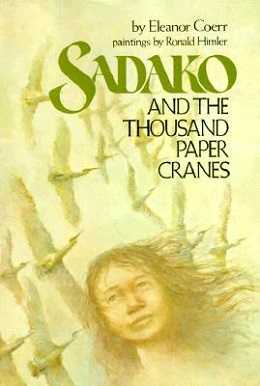Sadako and the Thousand Paper Cranes facts for kids

First edition
|
|
| Author | Eleanor Coerr |
|---|---|
| Illustrator | Ronald Himler |
| Country | Canada |
| Language | English |
| Series | None |
| Subject | Sadako 1000 Paper Cranes |
| Genre | Children's non-fiction literature |
| Publisher | G. P. Putnam's Sons |
|
Publication date
|
1977 |
| Media type | Print (Paperback, Hardcover) |
| Pages | 80 |
Sadako and the Thousand Paper Cranes is a special book for children. It's a historical novel written by a Canadian-American author named Eleanor Coerr. The book came out in 1977. It tells the true story of a brave girl named Sadako Sasaki.
This book has been translated into many different languages. It's used in schools all over the world to teach about peace education.
Sadako's Story and the Paper Cranes
Sadako Sasaki was a young girl who lived in Hiroshima, Japan. She became very sick with leukemia, a type of cancer. This was caused by the radiation from the atomic bomb that was dropped on Hiroshima.
A friend told Sadako about a Japanese legend. It said that if someone folded one thousand origami paper cranes, they would be granted a wish. Sadako started folding cranes, hoping her wish to get well would come true. She dreamed of being able to run again.
In the book, Sadako folds 644 cranes before she becomes too weak. She passes away on October 25, 1955. Her friends and family then finish folding the rest of the cranes. These cranes are buried with Sadako.
However, Sadako's older brother, Masahiro Sasaki, says the book's story is a little different from what really happened. He says Sadako actually folded more than 1,000 cranes. She folded about 1,400 paper cranes before she died. Masahiro Sasaki has shared his sister's full story in his own book, The Complete Story of Sadako Sasaki.
Sadako's Legacy of Peace
After Sadako's death, her friends and schoolmates wanted to honor her. They gathered letters and worked to build a memorial. This memorial would be for Sadako and all the other children who died because of the atomic bomb.
In 1999, a statue of Sadako was placed in the Hiroshima Peace Memorial. This memorial is also known as the Genbaku Dome and is in the Hiroshima Peace Park. The statue shows Sadako holding a golden crane.
At the bottom of the statue, there's a special message: "This is our cry. This is our prayer. Peace on Earth." Every year on Obon Day, a Japanese holiday, thousands of people leave paper cranes near the statue. They do this to remember Sadako and to wish for peace.
Sadako's family has also donated some of her original cranes to important places around the world. These places include the National September 11 Memorial & Museum in New York City and Pearl Harbor in Hawaii. They also donated cranes to the Harry S. Truman Presidential Library and Museum.
Sadako has become a very important symbol of peace. Her story is taught in Japanese schools every year on the anniversary of the Hiroshima bombing. Many people around the world celebrate August 6 as an annual Peace Day.
Other Works About Sadako
Sadako's story has inspired many other books and movies.
- The Day of the Bomb (1961) by Karl Bruckner is another book about Sadako.
- Masahiro Sasaki, Sadako's brother, co-wrote The Complete Story of Sadako Sasaki in 2018. He wrote it with Sue DiCicco, who started The Peace Crane Project. This book shares many family photos.
- A movie called "Sadako and the Thousand Paper Cranes" was released in 1991. It was based on Eleanor Coerr's book.
- There are also plans for new movies about Sadako's story, including One Thousand Paper Cranes.
- A short film for children called "Orizuru 2015" was made in 2015. It's a friendship story with children from Los Angeles. Sadako's nephew appears in the film and sings a song about her life.
- A musical for young performers called "Peace on Your Wings" has been created. It's based on Sadako's life and her message of hope and peace.
There is also a statue of Sadako in the Seattle Peace Park. In 1990, at the Goodwill Games in Seattle, 400 schoolchildren handed out 20,000 paper cranes. This honored Sadako's memory and spread her dream for world peace.

